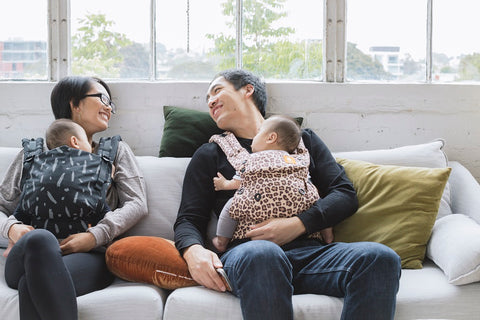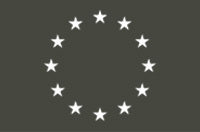
In view of the World Mental Health Days 2020, we want to focus on a rather heavy but important and ever-present topic: Postpartum depression. Many mothers are suffering from this illness that is slowly tainting the beautiful time with their newborn child. The good news about this dark topic is that medication is not always needed to treat a light or moderate form of postpartum depression. Dr Henrik Norholt, a scientist from Copenhagen, reveals alternatives to medication. Since 2001, he has been studying the effects that babywearing has on the parent’s psyche and the physical development of the child.
How babywearing can help with postpartum depression
Pregnancy is a very intensive period in a woman’s life, filled with emotions and dreams about the upcoming life as a mother. However, joyful expectations about finally being able to hold baby are not the only thing on the minds of future mothers. Some of them are also afraid of developing symptoms of postpartum depression.
This concern is not unfounded. Postpartum depression is an illness that can seriously restrict women of childbearing age. In the USA, it is the top reason for non-obstetric hospitalisation of women. One in five women are affected.
The problem is that it happens in a time when the newborn is in its most vulnerable state and is reacting in a very sensitive way to the mother’s mood and behaviour. That is why postpartum depression can heavily affect not only the child’s development but the whole family. Colic, sleep problems, behavioural problems, as well as later occurring reduction of mental performance and emotional maladaptation, can be linked to postpartum depression of the mother. Stopping breastfeeding too soon can also lead to postpartum depression.
In this article, we want to convey a basic understanding about the emotional reactions after childbirth. We will also discuss why skin-to-skin contact between parent and child and babywearing can contribute to the alleviation of postpartum depression since this link is rarely a focus of research. Websites about parenting and even websites about postpartum depression feature almost no articles about that topic.
How do I recognise postpartum depression?
First, what are the signs of postpartum depression? Doctors differentiate between “baby blues”, which can last from a few days up to two weeks and depression. Symptoms of depression last longer and are much stronger.
These are some typical symptoms of “baby blues”:
- mood swings
- anxiety
- sadness
- nervousness
- overstress
- crying
- concentration problems
- loss of appetite
- sleep problems
These are some typical symptoms of postpartum depression:
- depressive mood or extreme mood swings
- excessive crying
- difficulty bonding with the child
- withdrawal from family and friends
- loss of appetite or excessive eating
- insomnia or excessive sleeping
- overwhelming exhaustion or loss of energy
- no interest in activities
- extreme nervousness and anger
- fear of not being a good mother
- feelings of worthlessness, shame or guilt
- reduced ability to think clearly, concentrate or make decisions
- strong feelings of anxiety and panic attacks
- thoughts about self-harm or doing harm to the child
- recurring thoughts of death or suicide
Without treatment, postpartum depression can last for months or even longer and trouble the whole family. Therefore, it is no surprise that a lot of research is being conducted in order to alleviate this type of depression. Currently, the most relevant, medically approved types of treatment are talk therapy (interpersonal therapy, behavioural therapy, cognitive behavioural therapy) and treatment with medications. Taking medication during breastfeeding is a complicated and controversial topic if referring to antidepressants. Moreover, it is questionable whether those have an effect when used for treating light or moderate types of depression.
Alternative treatment methods
There are new insights that endurance training, meaning a workout that raises the heart rate, helps with depression in the same way that medication does. However, these insights are not widespread and are rarely used by medical personnel specialised in depression. New insights about non-medical, mutual social support have not yet been adequately investigated but can contribute to the recovery of affected mothers.
Apart from those two medically approved types of treatment, there are a variety of stress management tools that have been subjected to little research. Some of them are relaxation techniques, breathing exercises, body screening, guided visualisation techniques, touch therapy, light therapy, acupuncture, mindfulness meditation, yoga, tai chi, qigong, a healthy diet, social support and journaling.
Depression is a complicated matter for various reasons: Most people are not aware of the signs of depression. Even if a person recognises the symptoms of depression, the usual reaction is denial. That often has to do with the person’s self-image: “I’m not the type to have depression. I have to pull myself together and keep going”. Unfortunately, this attitude is likely to aggravate the depression. It’s a vicious cycle.
Another reason to deny one’s depression is the fear of being labelled as a “mentally disturbed person”, especially regarding a present or future job. What makes matters worse is that a newborn needs attention and care 24/7, which can lead to total exhaustion. Newborns usually react to their mother’s postpartum depression with colic, sleep- and eating problems which makes the situation even worse.
In search of a simple solution
Total exhaustion is not the best starting position, look for and work with an external specialist or mental health consultant. Even healthy mothers usually avoid contact with family and friends in the time after childbirth because the process of parent and child adapting to each other can be too fragile and energy-consuming.
To find a simple solution in the fight against postpartum depression would make things a lot easier. If there only was a way out of this state that wouldn’t take up too much of the mother’s energy, wouldn’t involve other people and could be put into practice at home – and all of that without having to tell anybody about being depressed…
A recently published Canadian study is raising hope among young mothers.
The study investigated two mildly affected groups of middle-class women. In the first month after birth, the first group initiated a few hours of physical contact per day between them and the baby (which they did). This suggestion was not made to the second group, and it turned out that the mothers from the second group actually initiated little or no physical contact with their newborns in the first month. Symptoms of depression were found in both groups in the first week and after one, two and three months.
However, the mothers who had daily physical contact with their babies showed significantly lower values on the depression scale (meaning they were less depressed) when the baby was approx. one week old and even lower values after a month. In the second and third months, in which symptoms of depression were quite low in both groups, no differences were found. For most mothers in both groups, the symptoms of depression were below the level of risk. However, some women showed values above the risk limits and consequently suffered more. Those mothers all belonged to the second group with no intense physical contact.
A look at the physiological stress marker, the level of cortisol found in the saliva in the morning, indicated that the mothers with intense physical contact showed a stronger decrease in cortisol during the first month after giving birth than the mothers of the second group.
This study was the first to investigate the effect of physical contact between mother and child on symptoms of depression over a period of several months. It provided important insights, and functions as a source of inspiration.
Exercise and fresh air versus antidepressants
Mothers, who experienced the advantages of close contact with their babies, are usually keen to try babywearing by using a baby sling or baby carrier. That enables the mother to go about her daily activities while being close to her baby. This way, she can supply her baby – and herself – with vital and age-appropriate stimuli.
If babywearing is combined with a quick morning walk, the physical exercise and natural light improve the effect. Interestingly, it has been found that light therapy (exposition to sunlight or electric sources similar to sunlight) and physical activity are more effective than common antidepressants. So, don’t underestimate the power of sunlight and fresh air.
Breaking the barriers of social isolation step by step with morning walks can enhance the desire to meet other mothers and talk about the joys and hardships of motherhood. If you are the only one in your group of friends who recently had a child, you have the possibility to join one of the many babywearing groups that are popping up everywhere right now. These groups usually organise open meetings in cafés or nearby establishments on a regular basis. The meetings are the perfect opportunity to form meaningful and inspirational friendships. If you cannot find a babywearing group near you, you can simply create a group yourself. You can find further information on that on http://babywearinginternational.org/.
Alternatively, you can join a workout group for mums. Researchers have also confirmed the positive effect of receiving and giving social support in the form of volunteering and doing charity work.
You will see: These simple steps will surely help to alleviate light or moderate forms of depression.

